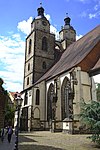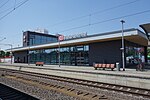Melanchthonhaus (Wittenberg)

The Melanchthonhaus is a writer's house museum in the German town of Lutherstadt Wittenberg. It is a Renaissance building with late Gothic arched windows and the broad-tiered gables. It includes the study of the influential Protestant Reformer Philipp Melanchthon, who lived there with his family. In 1954 the house became a museum on Melanchthon's life and work displaying paintings, prints and manuscripts by him and his contemporaries. In 1996, the building became a UNESCO World Heritage Site along with sites associated with Melanchthon's contemporary Martin Luther in Witternberg and Eisleben because of their religious significance and the lasting, global influence of Protestantism.
Excerpt from the Wikipedia article Melanchthonhaus (Wittenberg) (License: CC BY-SA 3.0, Authors, Images).Melanchthonhaus (Wittenberg)
Collegienstraße,
Geographical coordinates (GPS) Address External links Nearby Places Show on map
Geographical coordinates (GPS)
| Latitude | Longitude |
|---|---|
| N 51.864722222222 ° | E 12.650833333333 ° |
Address
Melanchthonhaus
Collegienstraße 60-61
06886 , Altstadt (Wittenberg)
Saxony-Anhalt, Germany
Open on Google Maps





